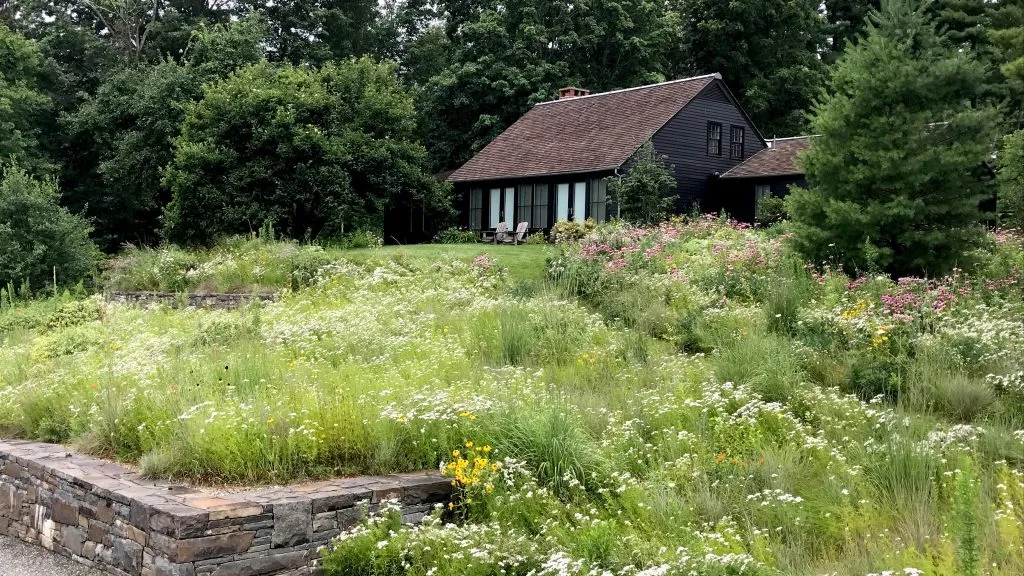
Consider the paradox: Americans use enormous quantities of water, fuel, fertilizers and pesticides to grow their lawns, only to dedicate enormous quantities of time and money to keep them short.
So why, even amidst growing ecological awareness, do these monocultures continue to dominate our public and private lands? Some lawns make sense, but the evidence points primarily to a lack of practical alternatives.
Designed meadows, on the other hand, have long been part of the great American landscape. Their lower-maintenance beauty would seem to make them an ideal substitute. Unfortunately, many of the prefab, meadow-in-a-can type seed mixes have done far more harm than good in the court of public opinion, creating unrealistic expectations and underwhelming returns.
One year of success, and a lifetime of weeds.
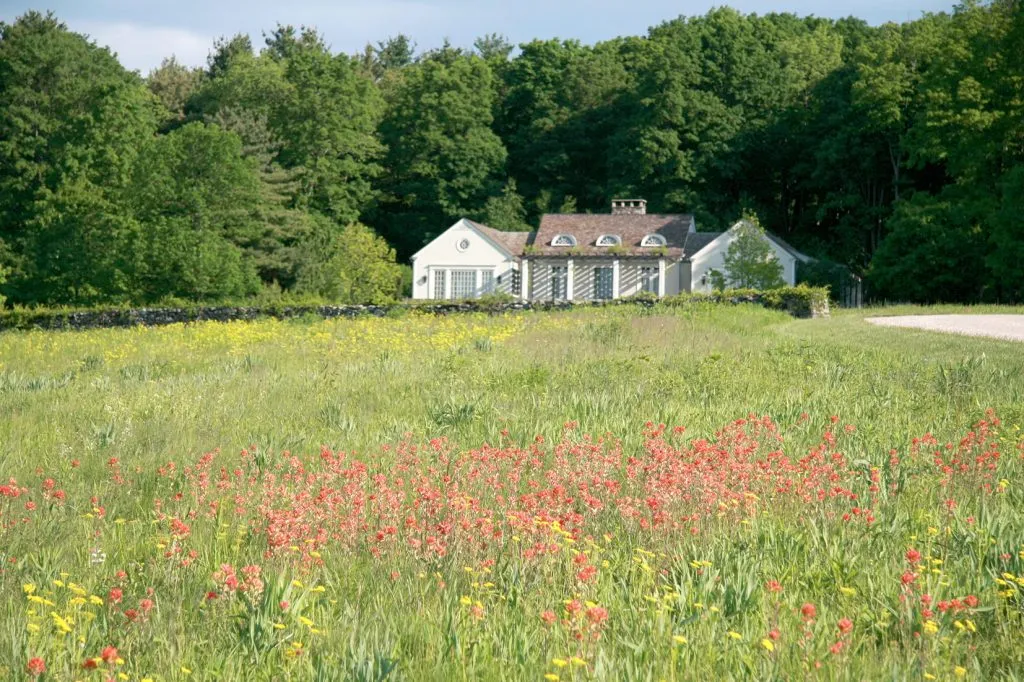
When planned, installed and managed properly, seeded meadows contribute tremendously to naturalizing the American landscape—and when integrated into a well-designed landscape matrix, a wildflower meadow can help transform a residential property into a beautiful and stimulating home environment while vastly reducing time spent with a noisy mower.
Apart from their residential applications, meadows can dramatically reduce maintenance costs over time and jump-start the visual and ecological diversity of universities, roadsides and public spaces.
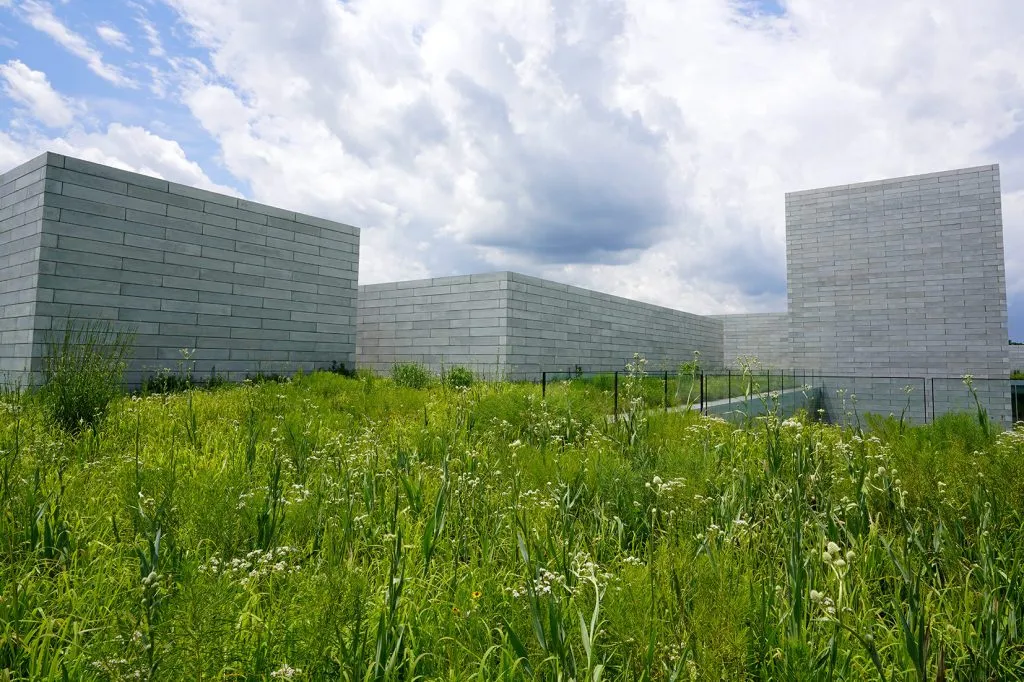
Before we get ahead of ourselves, we should clarify what we mean by native wildflower meadow. In order to reduce maintenance and achieve long-term sustainability, the meadow must strike a delicate balance between aesthetics and ecological functionality. Only by understanding and incorporating the compositions, patterns and processes inherent in our naturally occurring meadows and prairies can we create landscapes that will be viable over long periods of time without massive amounts of assistance.
Does this mean we must sacrifice aesthetics for sustainability?
Not at all. We need not lower expectations—only shift them.
Think native ornamental grasses, glimmering in the sun and swaying in the breeze, complemented by graceful drifts of wildflowers. More inspiring and certainly more sustainable than the oversaturated landscapes depicted on the seed packet.
Instead of waiting in dread to see what will emerge the second year after the annuals have expired, we can enjoy an ever-evolving natural landscape from season to season, and year to year, as it reflects the beauty and grace of our native meadows and prairies.
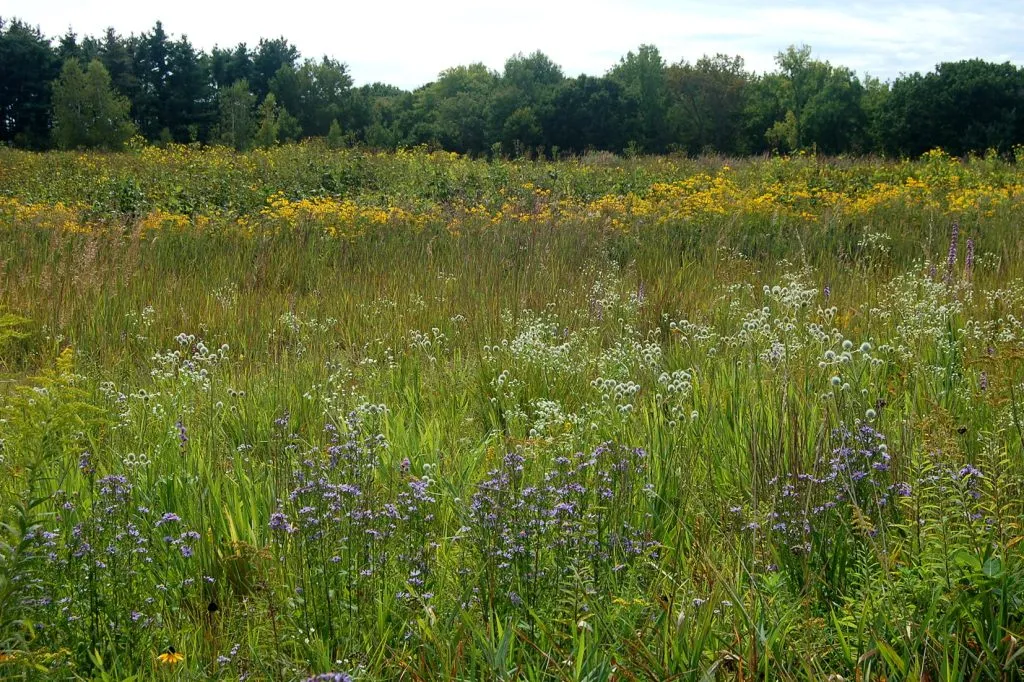
See it in your mind’s eye? While we’re both waxing poetic, the weeds are biding their time. So quickly, here are some of the most important elements for designing, implementing and managing a seeded native meadow.
SITE ANALYSIS
First order of business: Light exposure. Insufficient sunlight will favor woody species over herbaceous wildflowers and grasses, causing an increase in maintenance requirements.
Next up: soil type. It’s imperative to understand and identify which soil texture you’re working with (amount of sand, loam, clay, etc.) in order to select plants that will adapt successfully to the site. Understanding soil pH and amount of organic matter will also help you make decisions regarding plant community selections.
In many cases, poor soil can provide a competitive advantage to the meadow species. Many of the most notorious weeds favor richer soils while there are numerous native flowers and grasses that thrive in poor conditions. Plants with strong ornamental characteristics such as Butterfly Weed (Asclepias tuberosa) and Little Bluestem (Schizachyrium scoparium) will grow well in dry sands, while Pink Turtlehead (Chelone lyonii) and New England Aster (Symphyotrichum novae-angliae) will thrive and flower in poorly drained clay soils.
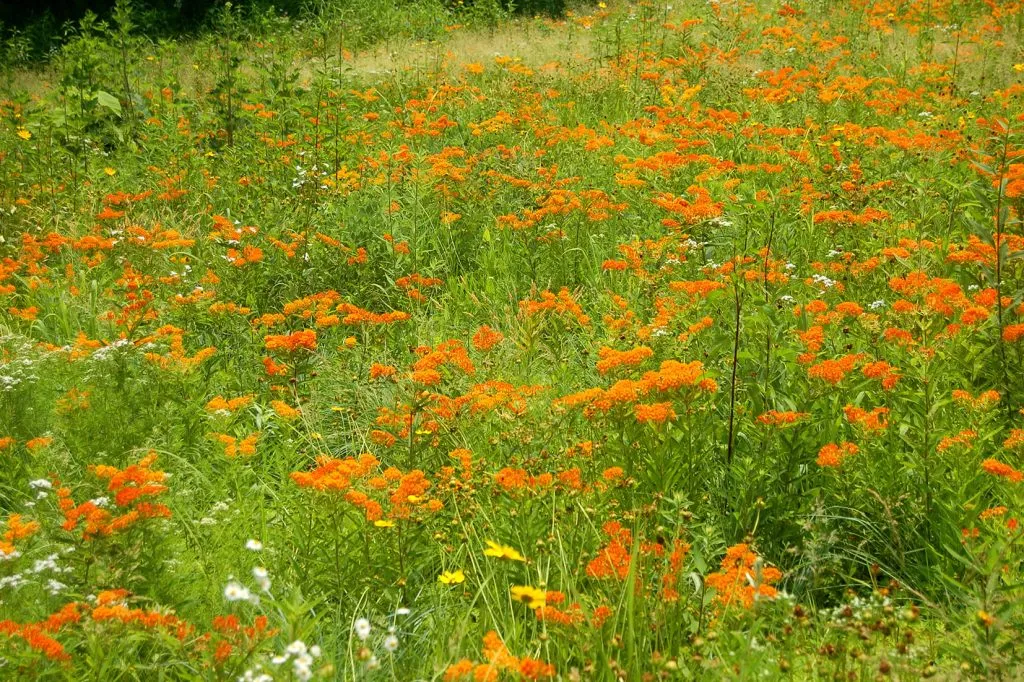
Nutrient levels are less important than in traditional landscapes, as most native plants are generally adapted to existing conditions. Barring an extreme deficiency, avoid fertilization as it will probably favor the weeds more than the desirable species.
Moreover, topography can affect a number of decisions in meadow planning. A north slope may not be favorable to meadow plants as they will receive less direct sunlight. If the meadow is in a low lying area and remains wet during spring thaw and rains, look for plants adaptable to these conditions. For seeding, a sloped site may favor spring as opposed to late fall in order to avoid washing of un-germinated, dormant seed during winter. As always, micro variations within the site may influence plant selection and placement in order to further match the plant to its proper environment.
Analyzing existing growth on and adjacent to the site can yield extremely valuable information relating to what plants will grow well on the site and what specific weedy species are likely to cause a problem. Eradicate problematic weeds ahead of time to avoid future headaches.
SEED MIX COMPOSITION
Based on site analysis, it’s time to select the plant species that will comprise your seed mix. The plants that will afford the best long-term results will invariably be those that are found in conditions similar to your site or native to the region.
Although the temptation is great to include showy exotic species with floral characteristics, their likelihood of survival is far lower. While marginally adapted plants can survive in a cultivated garden where competition is weeded out, in a highly competitive meadow planting, only the most adapted vigorous plants will survive.
As in most naturally occurring meadows and prairies, grasses should be a major component of the plant mix. They are the single most important component in stabilizing the meadow from both a functional and visual point of view. Only clump-forming grasses should be used such as Little Bluestem (Schizachyrium scoparium), Indian Grass (Sorghastrum nutans), and Purple Lovegrass (Eragrostis spectabilis).
It’s worth noting that we often choose to include a nurse crop composed of fast germinating, clump-forming grasses such as Grain Rye or Common Oats to help secure the site from weed invasion and erosion during the first season.
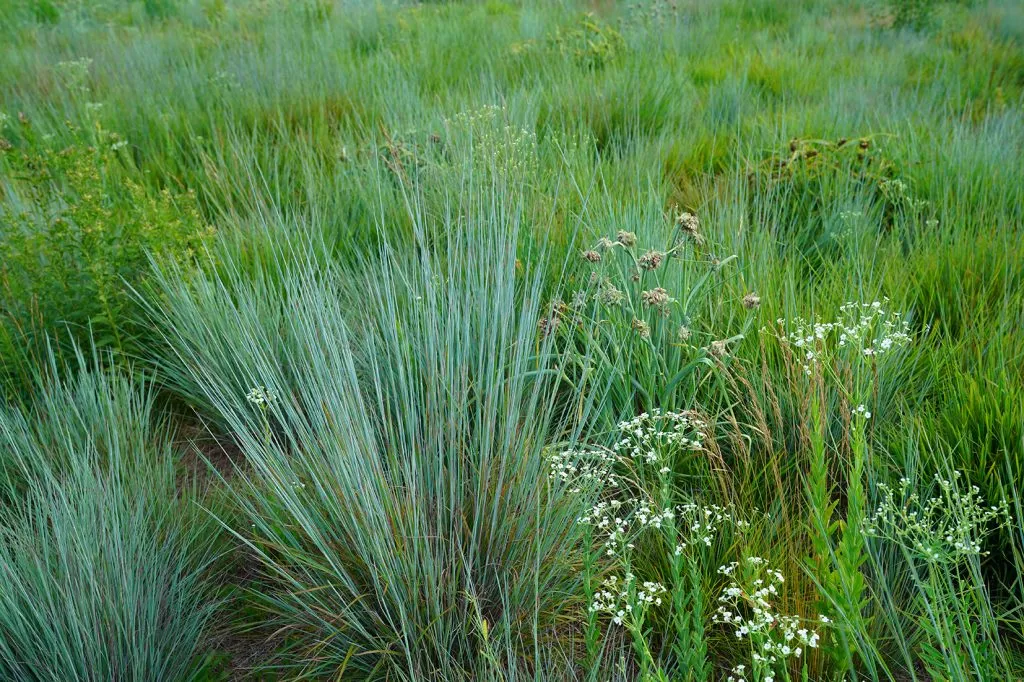
UNDERSTANDING NICHE
A study of a mature Midwestern prairie will reveal an incredibly dense tapestry where every possible space is occupied. A tiny section of five foot prairie will contain a canopy, numerous mid layers and a creeping understory. Mat-forming root systems occupy the upper soil layers while deep fibrous and tap roots hold down the fort below. If all of these elements are present, the meadow will have a strong capability to resist weeds. There is no place left for them to grow.
In addition to filling these various niches in space, you need to fill the niches in time.
The first is seasonal time: Some plants are active in warm weather while some plants are most vigorous during the cool seasons, particularly spring. By including both types, there will be no seasonal opening for weed invasion.
The second is measured in years: Some plants establish a cover during the first year—some during the first few years while other long-lived plants may not have a serious presence for many years. All of these need to be present to avoid a weak stage in the meadow’s competitive ability.
Unfortunately, the vast majority of cookie-cutter seed mixes on the market have given little or no thought to any of these functional considerations. They are mostly composed of annuals, biennials and short-lived perennials selected for quick results at a cheap price. It is very unlikely they’ll last more than a year or two. Fortunately, mixes that take into account change over time are becoming increasingly available from reputable seed houses.
While a seed mix designed for the long term will take about two years to produce flowers and inevitably stretch the budget, long-lived perennials are more interested in expending their energy on early vegetative growth to gain a foothold amongst the competition. A far more comprehensive, sustainable and fruitful path to a healthy meadow.
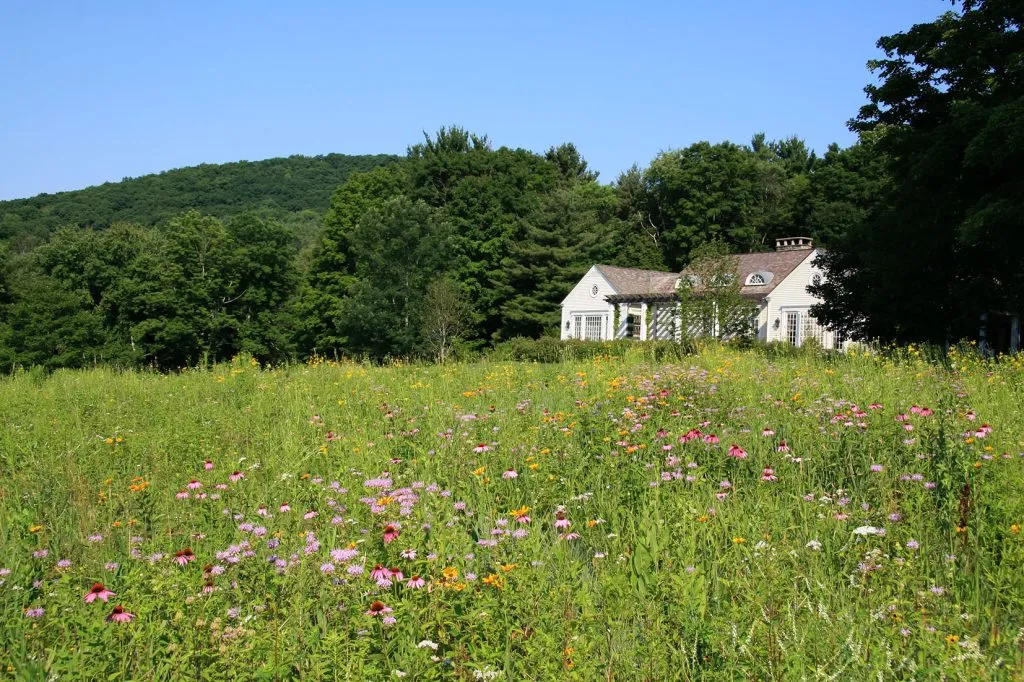
There’s one last item on the seed mix wish list. Even if the seed composition contains sufficient long term, competitive plants to produce a sustainable meadow, these mixes need to be available not only according to geographical region, but by soil preference. Meadow mixes formulated for dry, mesic, and wet soil conditions, composed of plants native to the particular region will undoubtedly serve as the best possible foundation for a successful and efficient mix.
Seeding by individual species, you can further fine-tune the site adaptability of your plant composition and segregate species according to micro areas within the site. Individual species selection can also allow for additional design flexibility regarding the aesthetic aspects of the meadow. Additional considerations include bloom succession, foliage textures and combinations of flower color and forms.
It may be wise to include plants that encourage wildlife, adding another dimension to the enjoyment of the landscape. The seed heads of many of the grasses and wildflowers will attract birds to the meadow (Liatris, Rudbeckia), particularly in winter, while a number of meadow plants are particularly attractive to Hummingbirds (Lobelia, Monarda, Penstemon).
Diversity in a meadow’s plant life also begets a diversity of insect life: pollinators of all sorts utilize meadows for their nectar and pollen; native Allium, Eupatorium, Eutrochium, Monarda, Phlox, Pycnanthemum, Symphyotrichum, Solidago and many other species are prized by insect pollinators.
Counterintuitively, when supporting butterflies and moths in particular, it’s best to think more about leaves than flowers. Many lepidopteran pollinators can thrive in a number of conditions, despite their caterpillars requiring specific host plants to thrive and survive. Famously, Asclepias is the only genus of plants that Monarch caterpillars can feed on, but many other pollinator species also need specific species or genera as host plants to support their young: plant Chelone to support the Baltimore Checkerspot, plant Zizia (and other Carrot family members) to support Black Swallowtails.
This just scrapes the surface of pollinator host plant interactions but underscores how important they can be to a flourishing meadow.
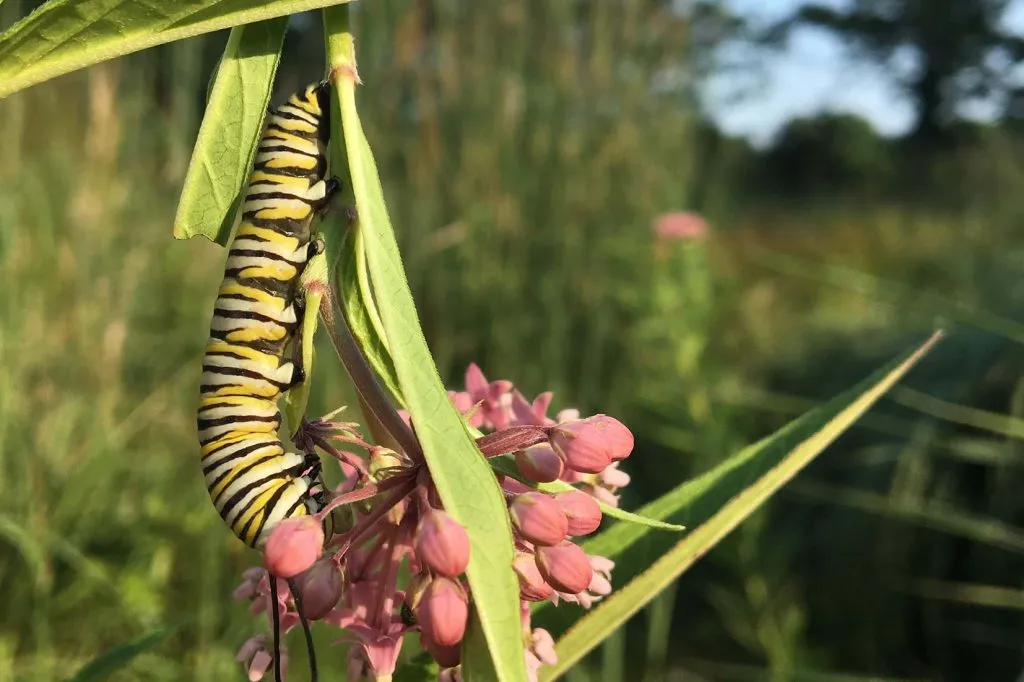
When it comes to installation, much of the process is similar to turf grass seeding. It’s necessary to create a finely graded seed bed and incorporate the seed into the soil.
Timing may vary in contrast to turf sowing: The fall is limited to late dormant seeding and the spring seeding period can extend into early summer. Late fall sowing is not recommended on sloped sites where erosion can be a problem.
All in all, site preparation is of the utmost importance in achieving a successful meadow. It begins with the elimination of existing growth, and the most common methods are several repeated applications of short lived herbicide, mechanical removal or a combination of the two. Mechanical removal will bring dormant weed seeds to the surface, which must be allowed to germinate to properly control before seeding.
SEED MIX LAYOUT
The best plant arrangements combine the designer’s creativity with the patterns that occur in nature, as naturally occurring meadows rarely have a homogeneous mix of species evenly scattered throughout the area. More commonly, an individual plant or plant group, usually including grasses, will dominate, with smaller colonies of plants occurring in pockets or drifts. Replicating this arrangement can yield a natural and appealing meadow which relies more on the form and textures of grasses interplaying with subtle touches of color, rather than an unattainably constant explosion of bloom.
Small pockets of an isolated species occasionally correspond to micro conditions such as a low moist area. By following the lay of the land in placement of plants or plant groups, you not only increase survivability of those plants, but create a landscape that automatically appears natural and graceful.
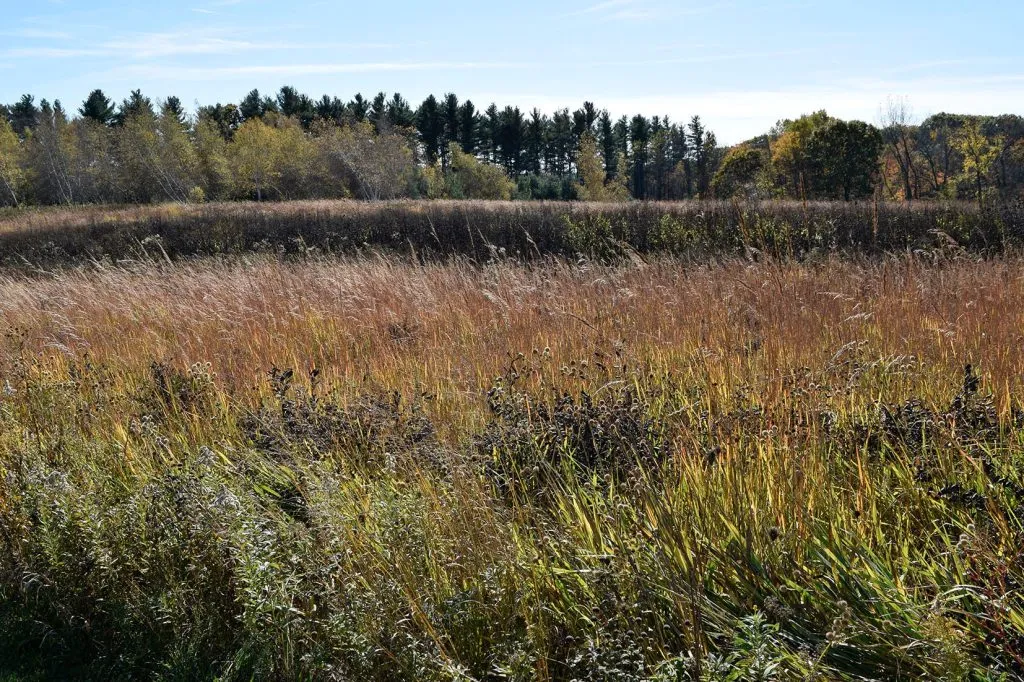
Meandering paths and secluded sitting areas can be seeded with low grasses and spring ephemeral flowers (Bluets: Houstonia caerulea, Violets: Viola species), mowed occasionally during the season for easy access. This can allow an appreciation of the sights, smells and sounds of the landscape from within, adding an experiential element to the planting and creating a graceful, aesthetically pleasing transition from the kempt to the wild.
POST PLANTING MANAGEMENT
Meadow maintenance requires a keen understanding of ecological succession: the process by which a disturbed area progresses naturally from herbaceous meadow (first annuals, then perennials) to woody shrubs and pioneer trees—and finally to a mature forest.
In dry portions of the country, various forms of prairie represent the mature stage of the process. In establishing a permanent meadow where woods naturally predominate, we are arresting the process of ecological development at the herbaceous perennial stage. By understanding nature’s next move, we’re better able to make intelligent decisions, resulting in less maintenance and a more successful end result.
On the client or steward’s end, it’s critical to understand that although the meadow will require substantially less maintenance than a mowed lawn, the first one to two years will require guidance to achieve successful results. Get a maintenance plan in place early to ensure everyone’s on the same page.
After seeding, weed control is key. The appropriate methods will be determined by the size of the project, maintenance budget, client preferences and emergent weed species, but as the process of ecological succession would suggest, the first year will bring a rapid cover of annual weeds while the perennial wildflowers and grasses are slowly developing underneath. This is to be expected, and if managed properly, won’t pose a problem.
During the first growing season after seeding, mowing the meadow every six weeks to a height of 4-6″ will prevent the annual weeds from seeding, nourishing perennial plants below your mow height with enough light for strong establishment. These perennials will emerge the following year far stronger than if they had been buried under four feet of annual foliage the first year.
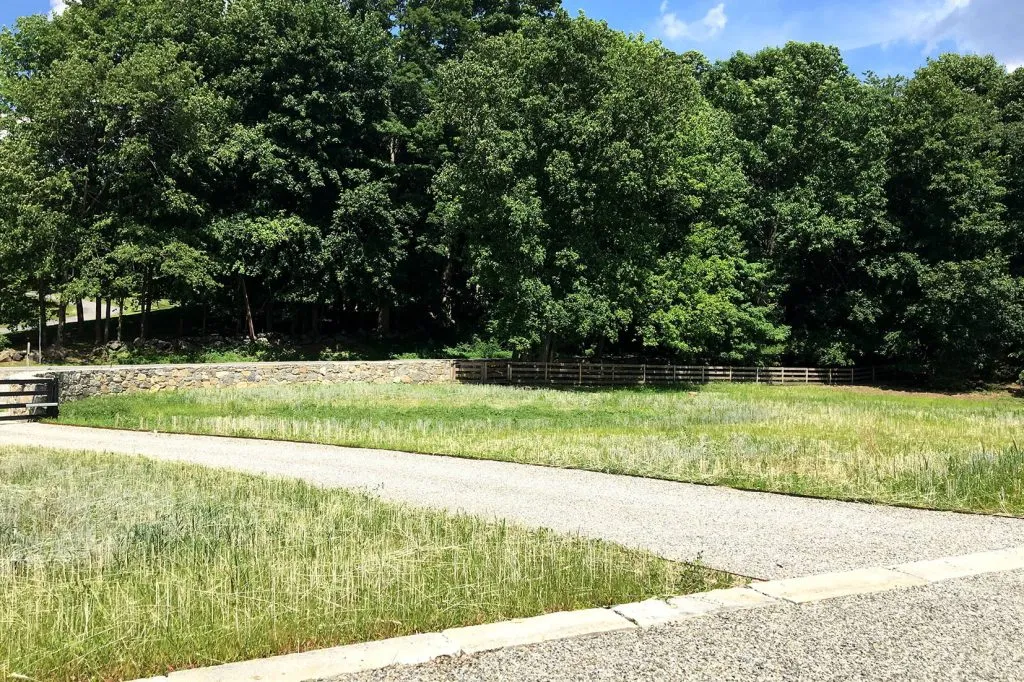
During the second year, the faster growing perennials (e.g. Black Eyed Susan: Rudbeckia hirta, Purple Coneflower: Echinacea purpurea, and Bee Balm: Monarda fistulosa) will begin to provide color and the entire planting should be well enough established to allow a decrease in weed control. If necessary, periodic weed control can include spot herbicide application, manual weeding or an additional cutting during the most active growth period of the problem weed.
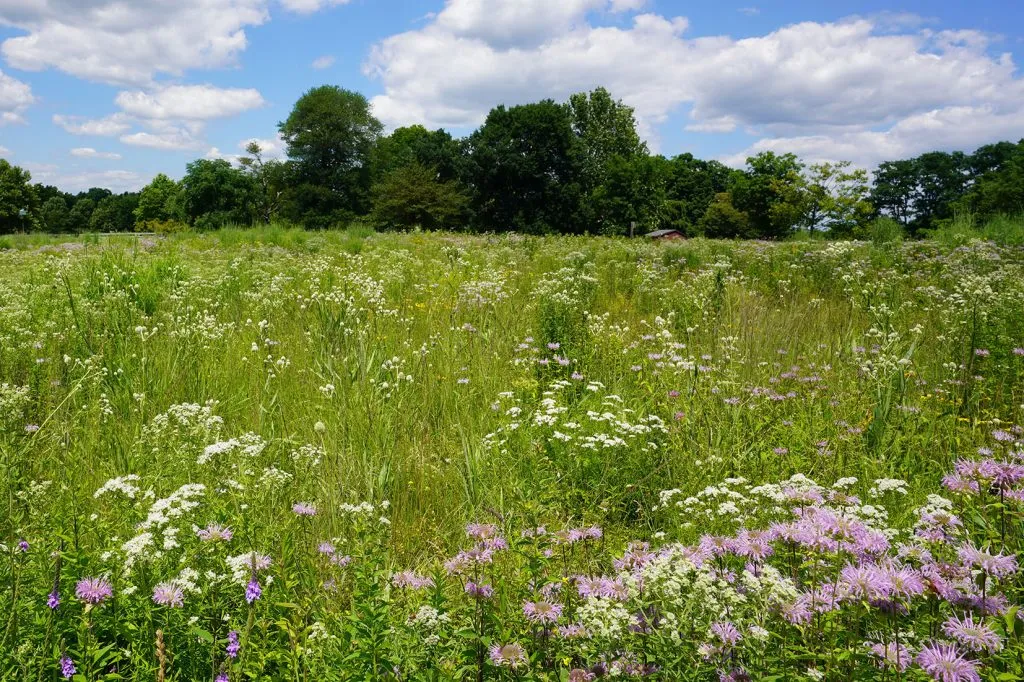
By the third year, the native meadow plants should be fairly dominant on the site and able to resist weed invasion with minimal management. Maintenance will consist of periodic monitoring, spot wed control, and one mowing or burn either in the late winter or early spring.
Once established, the native meadow planting exemplifies a beautiful synthesis of horticulture, design and ecology, resulting in an easily managed, ecologically sound and visually dynamic landscape to be enjoyed for years to come.
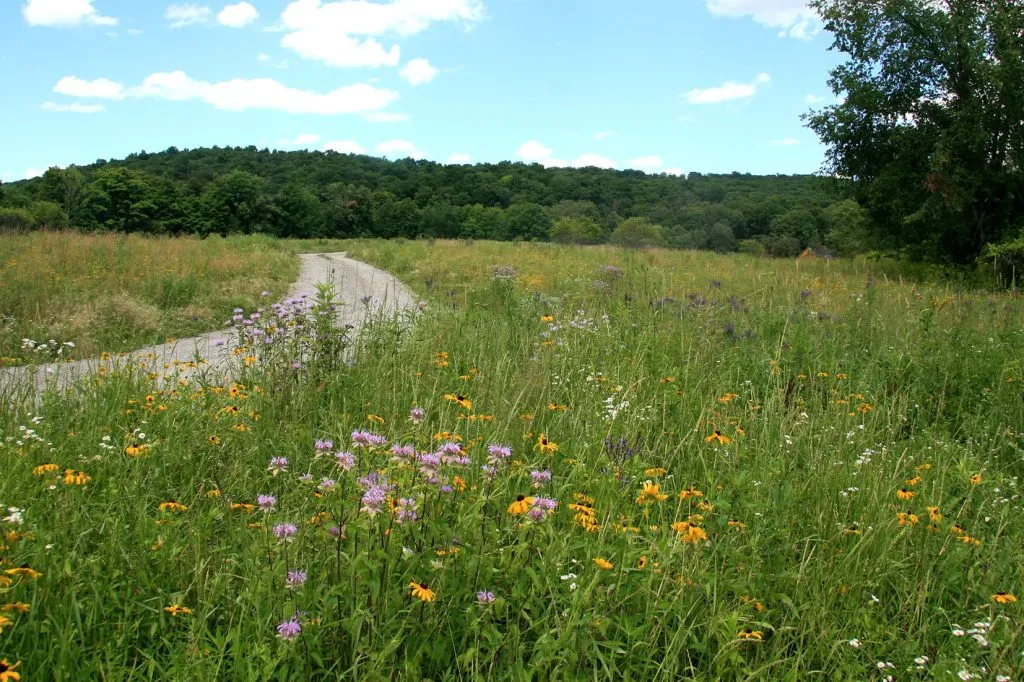
The current trend toward ecological concern, economy and appreciation of the natural world has created a public eager for new ways to incorporate nature into their homes, businesses and public lands. Native meadow and prairie plantings jive well with these emerging attitudes, presenting an outstanding opportunity for those landscape designers, architects and planners who have tried to understand the ecological principles needed for their successful design and implementation.
Recommended Perennial Wildflowers for Northeastern Meadows
(D=dry, M=mesic, W=wet)
Agastache foeniculum – Anise Hyssop | D/M
Asclepias tuberosa – Butterfly Weed | D/M
Asclepias incarnata – Swamp Milkweed | M/W
Chamaecrista fasciculata – Partridge Pea (self seeding annual) | D/M
Coreopsis lanceolata – Lance Leaf Coreopsis | D/M
Echinacea purpurea – Purple Coneflower | D/M
Eryngium yuccifolium – Rattlesnake Master | D/M
Eupatorium fistulosum – Joe Pye Weed | M/W (spot sow)
Hypericum punctatum – Dotted St. John’s Wort | D/M
Liatris species – Blazingstar | D/M/W
Lobelia cardinalis – Cardinal Flower | M/W
Lobelia siphilitca – Blue Lobelia | M/W
Mimulus ringens – Monkey Flower | W
Monarda fistulosa – Bergamot | D/M (spot sow)
Monarda punctata – Dotted Horsemint (self seeding biennial) | D/M
Parthenium integrifolium – Wild Quinine | D/M
Penstemon species – Beardtongue | D/M
Pycnanthemum species – Mountain-mint | D/M/W
Rudbeckia hirta – Black-eyed Susan (self seeding biennial) | D/M
Solidago species – Goldenrod | D/M/W (Do not use Solidago canadensis, S. altissima, S. gigantea, or S. rugosa; all of which, while native are highly vigorous and tend to overwhelm desired vegetation.)
Symphyotrichum laeve – Smooth Blue Aster | D/M
Symphyotrichum lateriflorum – Calico Aster | M/W
Tradescantia ohiensis – Spiderwort | D/M
Verbena hastata – Blue Vervain | M/W
Vernonia novaboracensis – Ironweed | M/W (spot sow)
Zizia aurea – Golden Alexander | M/W
Recommended Grasses, Sedges, + Rushes for Northeastern Meadows
Andropogon gerardii – Big Bluestem | D/M (spot sow)
Bouteloua curtipendula – Sideoats Grama | D/M
Carex brevior – Plains Oval Sedge | D/M
Carex vulpinoidea – Fox Sedge | M/W
Juncus tenuis – Poverty Rush | D/M/W
Juncus effusus – Common Rush | M/W
Schizacharium scoparium – Little Bluestem | D/M
Tridens flavus – Purpletop | D/M/W
Common Problem Weeds in Northeastern Meadows
Artemisia vulgaris – Mugwort
Cirsium arvense – Canada Thistle
Celastrus orbiculatus – Oriental Bittersweet
Elaeagnus umbellata – Autumn Olive
Festuca species – Fescue species (as well as other Eurasian cool-season pasture grasses)
Lespedeza cuneata – Sericea Lespedeza
Lonicera japonica – Japanese Honeysuckle
Phalaris arundinacea – Reed Canary Grass
Phragmite australis – Common Reed
Rosa multiflora – Multiflora Rose
Securigera varia – Crownvetch